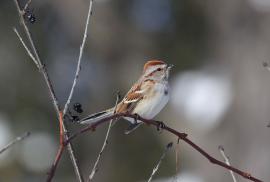Guide to Boreal Birds
Overview
This northern species is a winter visitor to the continental United States. Unlike northern finches such as Pine Siskins and crossbills, its numbers seem to depend on weather, not on the food supply -- the birds are less numerous in mild winters. These birds can tolerate subzero temperatures if they get sufficient calories from their seed diet; thus they are able to winter in open country where snow does not entirely cover the weeds and grasses. They are more commonly seen in brushy pastures at the edges of fields and woods. They roam the snow-covered landscape in flocks, uttering tinkling calls and often visiting feeders. The species reaches its highest wintering abundance in the midwestern U.S. A study in Iowa estimated that American Tree Sparrows consume 875 tons of weed seeds from the state every winter.
Description
5 1/2-6 1/2" (14-17 cm). Gray head with rufous crown and ear stripe; streaked brown above; 2 prominent wing bars; plain gray below, with dark spot in center of breast. Similar to Field Sparrow, but larger and without white eye ring or pink bill.
Voice
1 or 2 clear notes followed by a sweet, rapid warble. Winter feeding call a silvery tsee-ler.
Nesting
4 or 5 pale blue eggs, speckled with brown, in a bulky, well-insulated cup of bark strips and weed stems lined with feathers and hair, concealed in low tundra vegetation.
Habitat
Arctic willow and birch thickets; fields, weedy woodland edges, and roadside thickets in winter.
Range/Migration
Breeds from Alaska, northern Saskatchewan, northern Manitoba, and northern Quebec south to northern British Columbia, central Quebec, and Newfoundland. Winters regularly across most of United States south to California, Arkansas, and Carolinas.



